Abstract
This prospective randomised study examined the possibility of early resumption of oral hydration and discontinuation of intravenous fluid replacement after emergency or elective abdominal surgery. Following elective cholecystectomy alone or with a choledocholithotomy or an emergency Hartmann's procedure for large bowel obstruction, patients were randomised to early oral hydration (sips of water for 12 h followed by free fluids by mouth for 24 h, when oral intake of food was allowed--intravenous hydration was discontinued 6 h after starting the intake of free fluids orally) or conventional intravenous hydration (intravenous hydration and an oral regimen of water as follows: sips every hour for 12 h, 30 ml every hour for 24 h, 60 ml every hour for 24 h, 90 ml every hour for 24 h, free fluids for 12 h, when food was allowed--intravenous hydration was discontinued 6 h after starting the free fluids). The two regimens were equally effective in maintaining fluid balance and normal plasma and urinary electrolytes without any observed differences in biochemical or metabolic values. Each of free fluids by mouth, discontinuation of intravenous hydration, and consumption of solid food were achieved in the patients on early oral hydration at time periods significantly shorter than those attained with the conventional regimen (P less than 0.001). Similarly, patients on the latter regimen were hospitalised for significantly longer times than those on early oral hydration (P less than 0.001). Early oral hydration after biliary surgery or a Hartmann's procedure effectively maintains fluid balance and has advantages over the conventional intravenous hydration regimen.
Full text
PDF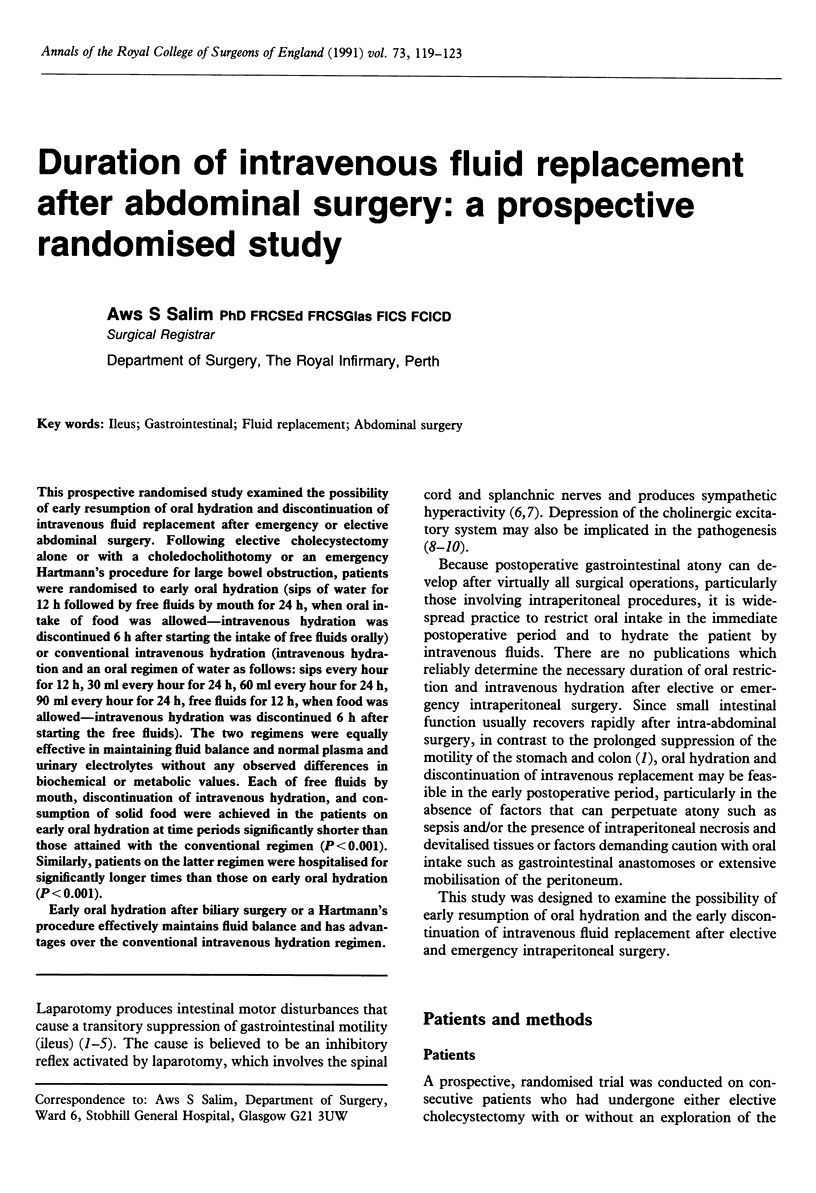
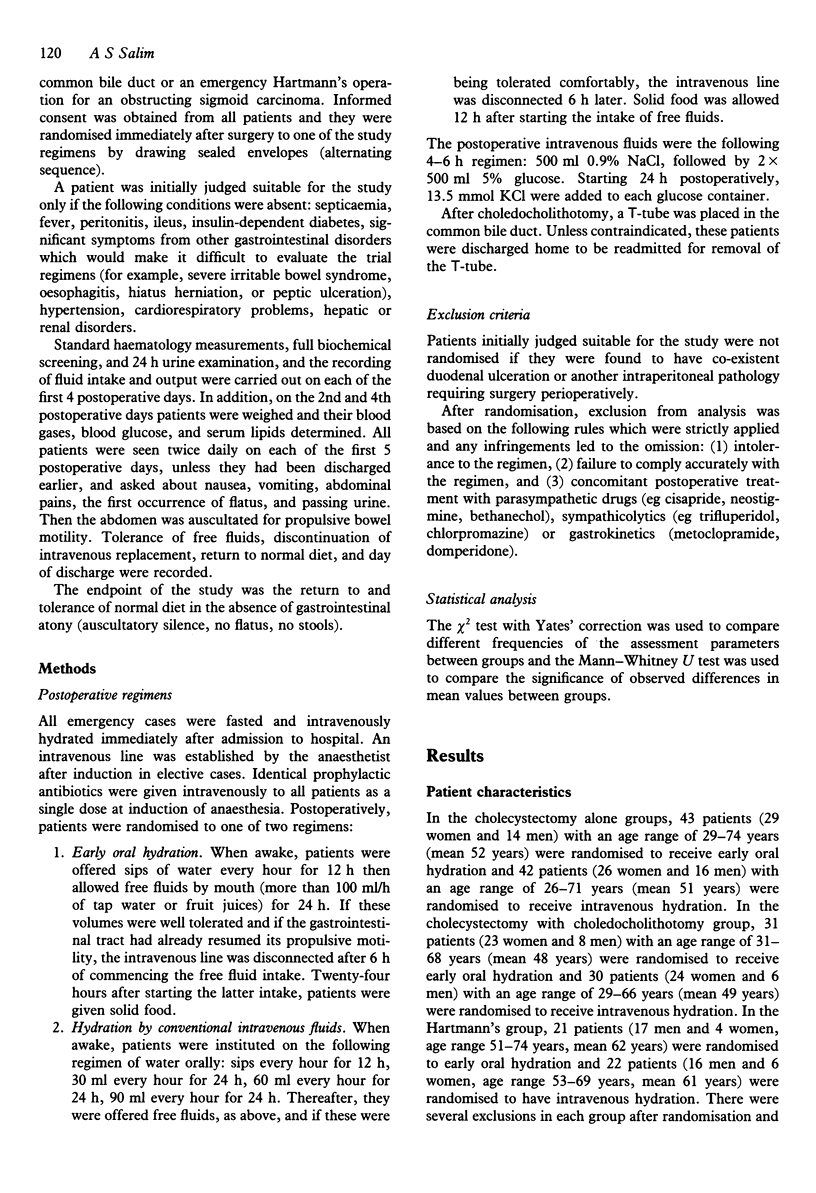
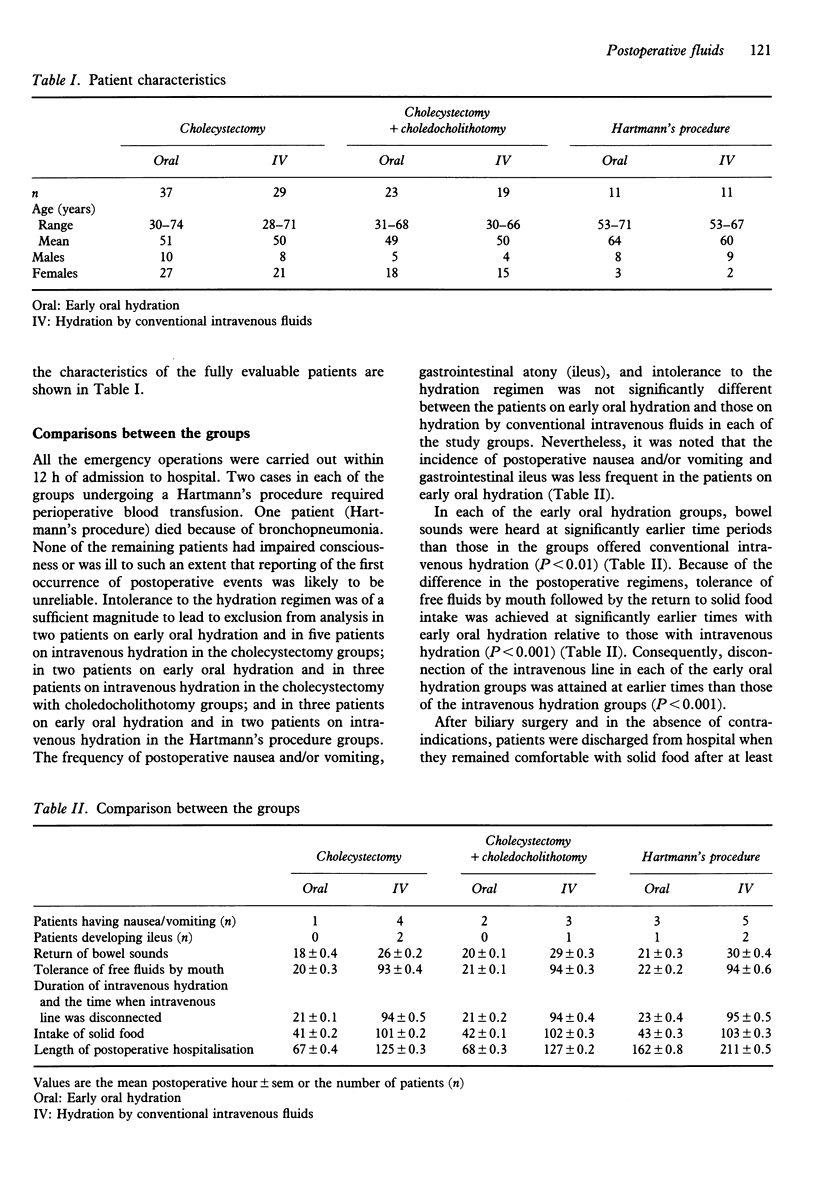
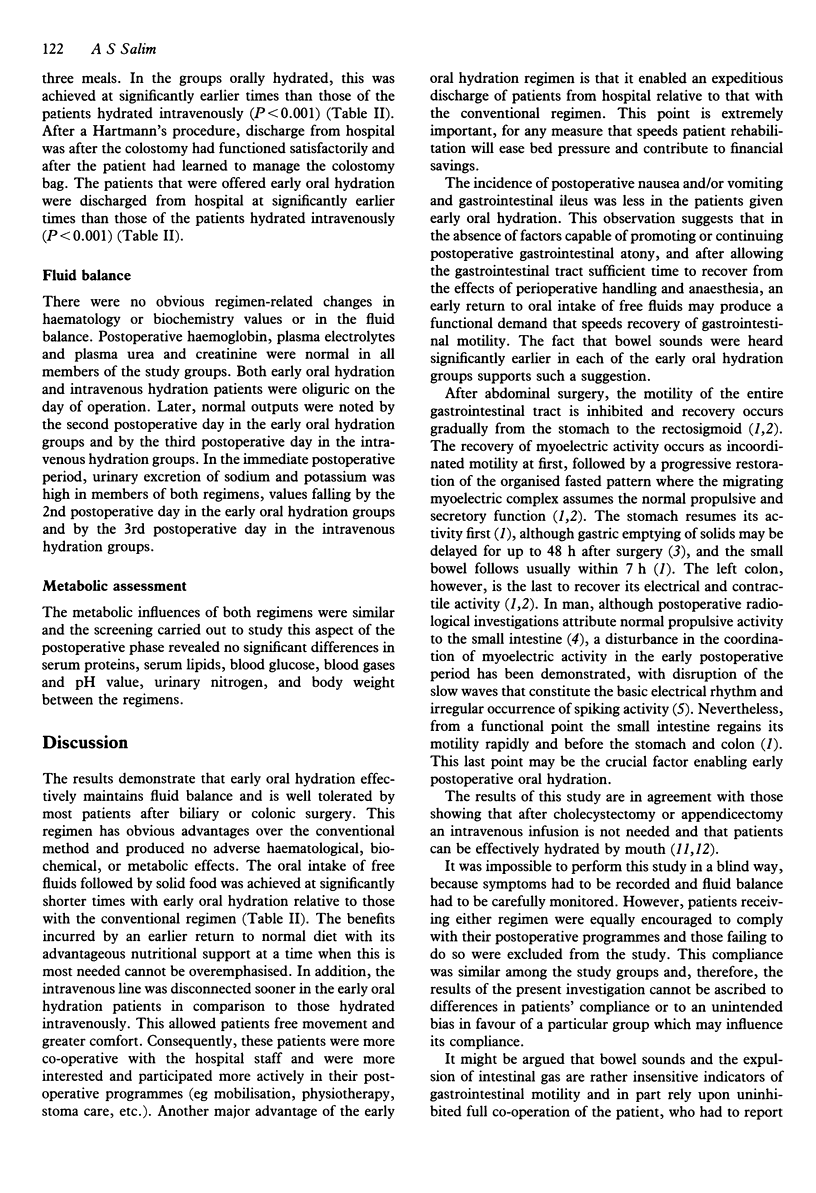
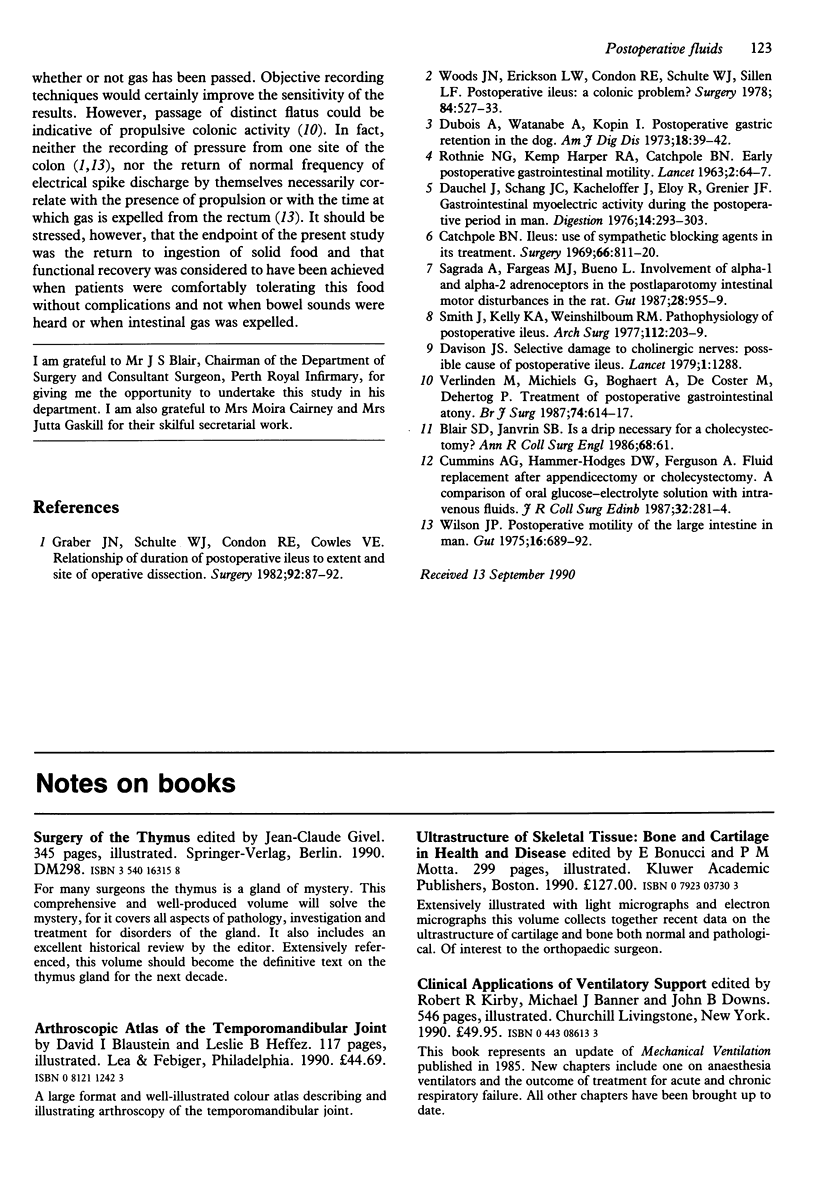
Selected References
These references are in PubMed. This may not be the complete list of references from this article.
- Blair S. D., Janvrin S. B. Is a drip necessary for a cholecystectomy? Ann R Coll Surg Engl. 1986 Mar;68(2):61–61. [PMC free article] [PubMed] [Google Scholar]
- Catchpole B. N. Ileus: use of sympathetic blocking agents in its treatment. Surgery. 1969 Nov;66(5):811–820. [PubMed] [Google Scholar]
- Cummins A. G., Hamer-Hodges D. W., Ferguson A. Fluid replacement after appendicectomy or cholecystectomy. A comparison of oral glucose-electrolyte solution with intravenous fluids. J R Coll Surg Edinb. 1987 Oct;32(5):281–284. [PubMed] [Google Scholar]
- Dauchel J., Schang J. C., Kachelhoffer J., Eloy R., Grenier J. F. Gastrointestinal myoelectrical activity during the postoperative period in man. Digestion. 1976;14(4):293–303. doi: 10.1159/000197944. [DOI] [PubMed] [Google Scholar]
- Davison J. S. Selective damage to cholinergic nerves: possible cause of postoperative ileus. Lancet. 1979 Jun 16;1(8129):1288–1288. doi: 10.1016/s0140-6736(79)92241-4. [DOI] [PubMed] [Google Scholar]
- Dubois A., Watanabe A. M., Kopin I. J. Postoperative gastric lleus. Am J Dig Dis. 1973 Jan;18(1):39–42. doi: 10.1007/BF01072236. [DOI] [PubMed] [Google Scholar]
- Graber J. N., Schulte W. J., Condon R. E., Cowles V. E. Relationship of duration of postoperative ileus to extent and site of operative dissection. Surgery. 1982 Jul;92(1):87–92. [PubMed] [Google Scholar]
- ROTHNIE N. G., HARPER R. A., CATCHPOLE B. N. Early postoperative gastrointestinal activity. Lancet. 1963 Jul 13;2(7298):64–67. doi: 10.1016/s0140-6736(63)90064-3. [DOI] [PubMed] [Google Scholar]
- Sagrada A., Fargeas M. J., Bueno L. Involvement of alpha-1 and alpha-2 adrenoceptors in the postlaparotomy intestinal motor disturbances in the rat. Gut. 1987 Aug;28(8):955–959. doi: 10.1136/gut.28.8.955. [DOI] [PMC free article] [PubMed] [Google Scholar]
- Smith J., Kelly K. A., Weinshilboum R. M. Pathophysiology of postoperative ileus. Arch Surg. 1977 Feb;112(2):203–209. doi: 10.1001/archsurg.1977.01370020097011. [DOI] [PubMed] [Google Scholar]
- Verlinden M., Michiels G., Boghaert A., de Coster M., Dehertog P. Treatment of postoperative gastrointestinal atony. Br J Surg. 1987 Jul;74(7):614–617. doi: 10.1002/bjs.1800740727. [DOI] [PubMed] [Google Scholar]
- Wilson J. P. Postoperative motility of the large intestine in man. Gut. 1975 Sep;16(9):689–692. doi: 10.1136/gut.16.9.689. [DOI] [PMC free article] [PubMed] [Google Scholar]
- Woods J. H., Erickson L. W., Condon R. E., Schulte W. J., Sillin L. F. Postoperative ileus: a colonic problem? Surgery. 1978 Oct;84(4):527–533. [PubMed] [Google Scholar]


